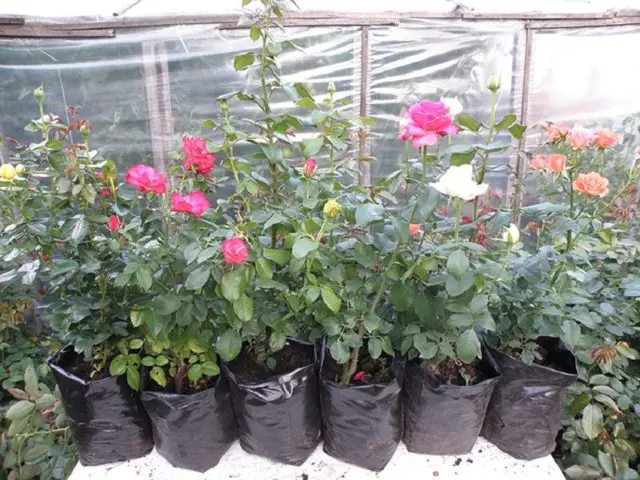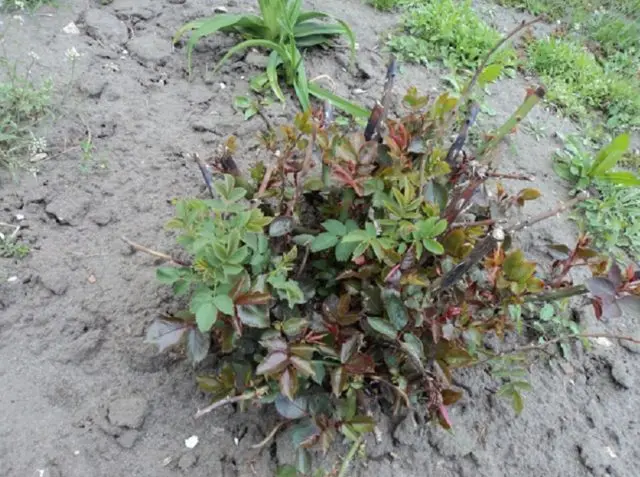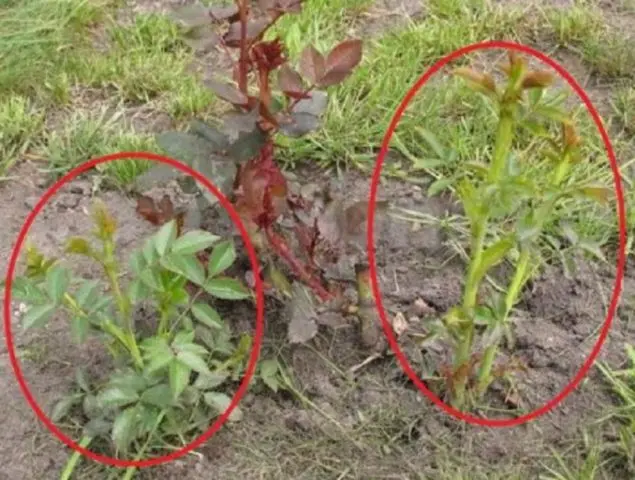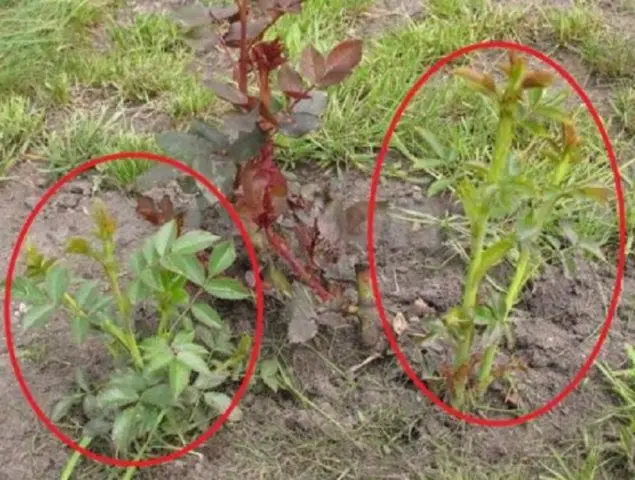Contents
The rose turns into a wild rose for various reasons. To prevent such a rebirth, gardeners are striving to find out the most effective methods of prevention. It is possible to save your favorite flower. It is important to act competently and quickly, not allowing a wild plant to destroy the queen of the garden.

It is possible to preserve the beauty of a variety only with certain agricultural techniques.
Can a rose be reborn into a wild rose
Roses are usually propagated by vegetative means. However, in regions with a cool climate, gardeners face difficulties. Even with successful rooting, own-rooted bushes do not always withstand the winter temperatures of the middle zone and northern regions. Here, the grafting of a cultivar onto a wild rose rootstock comes to the aid of flower lovers. A similar breeding technique is used for all types of roses – tea, climbing, standard. It is very comfortable and gives excellent results. But, for a rose, there is always the danger of being reborn into a wild rose.
If shoots begin to develop on the plant below the grafting site, this will be the growth of a “wild”. It is much more stable than a cultivated bush, able to withstand sharp temperature and climatic fluctuations. Therefore, the rebirth of a rose into a wild rose is a fairly common process.
Can a climbing rose be reborn into a wild rose
Climbing varieties are also grafted onto wild rose hips. Therefore, they are able to be reborn, like other species. When reborn, the plant expels shoots below the grafting site with a full set of wild rose characteristics. The growth often appears at some distance from the bush or in its middle.
Why and when a rose turns into a wild rose
The reasons for this transformation must be known even before the variety is planted on the site. Otherwise, the gardener may not notice obvious signs and miss the moment of saving the cultivated plant.
There are several main reasons for the transformation:
- Poorly grafted seedling. If rosehip buds remain below the vaccination, then they will definitely give its shoots. Cultural branches will receive less nutrition, weaken and stop developing. As a result, the rose may die. Here, the attentiveness and literacy of the gardener also plays an important role when buying a seedling of a garden variety.

Despite the fact that the seedlings are in containers, the grafting site should be inspected
- Rootstock and scion incompatibility. This happens when a cultivar is grafted into a rose hip species with aggressive growth. It is able to form powerful shoots from the roots, which inhibits the growth of cultivated shoots.
- Wrong landing. If the place of the scion is not deepened, then it can dry out. It is recommended to deepen the grafting point by 7-8 cm.
- Violation of agrotechnical requirements. It is necessary to protect the thickening at the bottom of the seedling from frost. To do this, carry out hilling and protect from freezing with the help of shelter. It is important to learn how to correctly cut the bush. Be sure to carry out a summer procedure, make a cut on the external kidney. Regularly remove weakened, diseased and damaged shoots. If the procedure is performed in violation of the rules, then this will lead to the degeneration of a cultivated bush into a wild one. You should also carefully carry out preventive spraying. The spread of diseases or pests is another reason for the death of a rose and the degeneration of a bush into a wild rose.

Removal of faded buds stimulates the growth of cultivated shoots
Video about the reason why a rose is reborn into a wild rose:
How to determine that a rose is turning into a wild rose
To do this, you need to know the main differences between cultivated and wild plants. Of course, an adult rosehip is quite easy to identify. It is much more difficult to notice young shoots. You can understand that a rose has gone into a wild rose according to several criteria:
- Shoots. In the “wild” they are painted bright green. They can germinate not only in the middle of the bush, but also at some distance from it. A breeding rose produces shoots of a reddish hue. The thickness of the branches also varies. Young shoots of wild rose are thinner, with a rare arrangement of leaves. A varietal plant expels stems that are more powerful and densely leafy.
- Leaves. They are glossy and large in varieties, leathery, dark green or reddish in color. The leaf tip is rounded. Rosehip branches are covered with small rough leaves of light gray or light green color with a sharp end.
- Thorns. The rose has shoots with large needles located at a considerable distance from each other. In wild rose, they are densely covered with small spines.

“Wild” shoots are easy to identify by external signs
You can also pay attention to the number of leaves. But with the modern development of breeding work, this criterion is not considered accurate. Many new varieties and hybrids of roses have the same number of leaves as rose hips. Therefore, if several of the above signs are found, measures to save the garden beauty should immediately begin.
How to fix and what to do if the rose has turned into a wild rose
Having determined that the rose has grown into a wild rose, you need to immediately reanimate the plant. To do this, the gardener should perform a number of simple, but effective actions:
- Dig up the soil at the location of the root system. Do it very carefully.
- Find the place of the scion and the point of germination of the overgrowth.
- Remove the growth that has appeared at the base. Do this not with secateurs, but with your hands. If the shoots are cut, they quickly grow back. Experienced gardeners claim that breaking out will protect the bush from the appearance of a “wild” for a longer period.It’s important! Cutting the undergrowth at ground level rather than at the base will produce a large number of new wild shoots.
- Treat the removal sites with iodine, brilliant green or sprinkle with charcoal.
The procedure must be carried out at least 2 times during the growing season. If the shoots appear again next year, you will have to repeat everything. It is important to remove all shoots that have sprouted. Even when they are significantly removed from the bush.

Unnecessary shoots should be removed at any distance from the bush
In some cases, wild rose shoots can completely replace the shoots of a cultivated plant. But even then you can make a rose out of a dog rose. It is recommended to plant cuttings of roses on wild rose to get a standard bush.
Another option is to transfer the rose to its own root system. Suitable only for winter-hardy varieties. The procedure is best done in the spring, when the soil warms up:
- dig a trench away from the trunk;
- lay cultural escape;
- fasten with a hairpin;
- sprinkle with loose nutrient soil, leaving the top in a vertical position above the ground (tie to a peg);
- a year later, transplant a new bush to a permanent place.
What to do so that roses do not grow into wild roses
You can help your favorite plant. To do this, there are a number of preventive measures that gardeners must know. And so that the rose does not go into the wild rose, they must be carried out in a timely manner. These activities include:
- Strict observance of agrotechnical requirements – proper pruning, competent watering and top dressing, This will provide the bush with good nutrition and the ability to resist the development of wild rose.

Proper implementation of any point of care increases the viability of the variety
- Regular inspection and removal of the “wild” shoots that have appeared.
- Replanting a bush to prevent running wild. A similar option is necessary if the scion site is not deep enough when planting. It is better to transplant the rose correctly, and at the same time check for the presence of buds and rosehip layering.
- Transferring a plant to its own root system.
Plant transplantation should be done like this:
- choose a favorable day with warm weather;
- fertilize and water a new pit;
- during a summer transplant, reduce the number of leaves by 1/3, remove the buds;
- dig a rose, carefully examine the place of vaccination;
- remove all buds and rose hips
- treat with an antiseptic;
- plant a rose in a new place, deepening the root collar by 7-8 cm;
- water and mulch.
It is best to transplant in autumn and early spring. Then skip the item with the removal of buds and leaves.
Transfer to own roots is only suitable for winter-hardy varieties. You need to choose the most powerful cultural escape. Make an annular incision, remove the green peel. The bare place should be at least 0,5 cm wide. Cover it with moistened sphagnum, fix it with a container. Water the moss periodically. After 1-1,5 months, the stem will form its own roots. When they develop and get stronger enough, separate the shoot from the bush and transplant it to a new place. Such a seedling is not threatened with rebirth.
For any rose prone to run wild, you need to create the most comfortable growing conditions. Very carefully fulfill all the requirements of agricultural technology, remove wild rose shoots in a timely manner, carry out competent pruning, and carefully prepare the bush for winter.
The possibility of rebirth depends on the quality of the planting material. Helping a plant when roses have become wild roses is much more difficult. And sometimes it’s completely impossible.
Conclusion
The rose turns into a wild rose and completely loses its decorative effect. If you follow the recommendations for protecting varietal roses from running wild, then the process can be stopped. Then there will be enough preventive measures so that your favorite plant will please you with its flowering for a long time.












